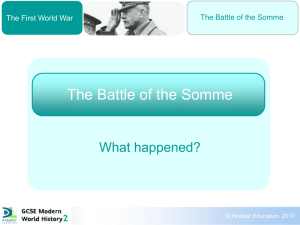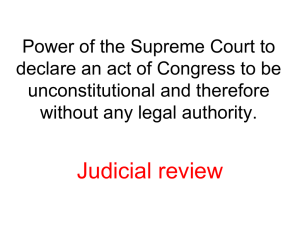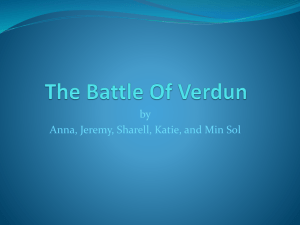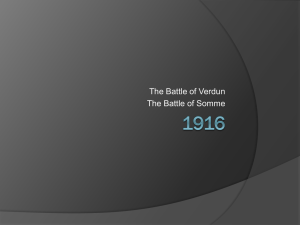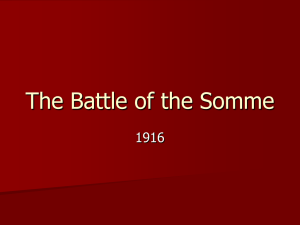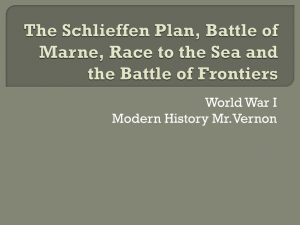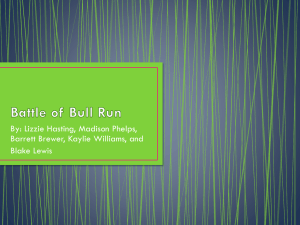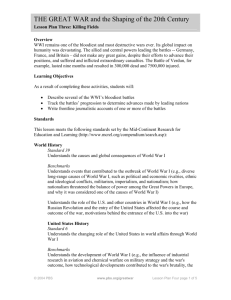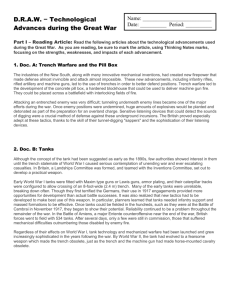World War I Stalemate - Riverdale High School
advertisement
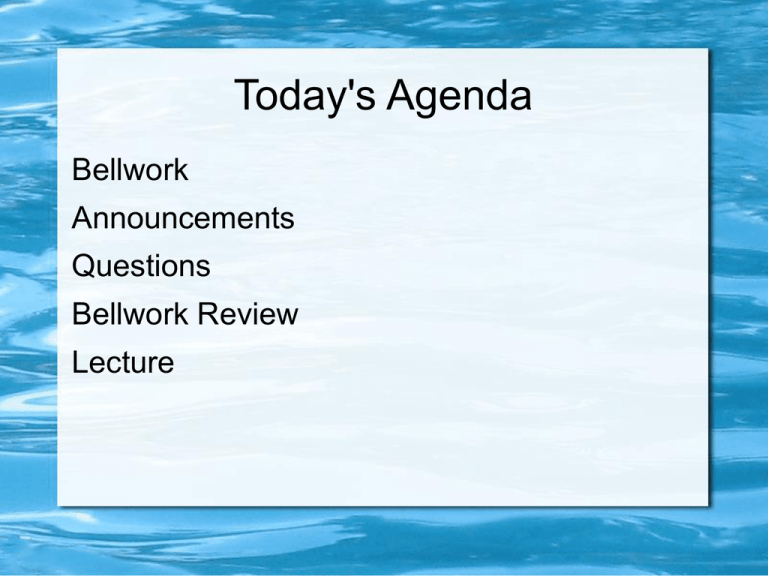
Today's Agenda Bellwork Announcements Questions Bellwork Review Lecture World Wars 1914-1945 Students analyze the causes and course of the First World War, along with the long-term military, economic, and political effects. Students describe the various causes and consequences of the global depression of the 1930s, and analyze how governments responded to the Great Depression. Students analyze the rise of fascism and totalitarianism after World War I. Students analyze the causes and course of World War II, along with the long-term military, economic, and political effects of the World War II Our Standards W.24 Trace the principal theaters of battle, major battles, and major turning points of World War I. (G, H, P) The Great War Video Time: https://www.youtube.com/watch?v=Mibe3zUg Z78 Schlieffen Plan Burning of Louvain Facts About Burning of Louivan http://www.telegraph.co.uk/news/worldnews/e urope/belgium/11053962/The-city-thatturned-Germans-into-Huns-marks-100years-since-it-was-set-ablaze.html People React to Burning of Louvain Theaters of War Western Front: http://www.greatwar.co.uk/places/ww1western-front.htm#mapwesternfront Battle of the Marne The First Battle of the Marne was conducted from the 6th to the 12th of September 1914, with the outcome bringing to an end the war of movement that had dominated the First World War since the beginning of August. Instead, with the German advance brought to a halt, stalemate and trench warfare ensued. http://www.pbs.org/greatwar/maps/maps_out break.html Battle of Tannenburg The Battle of Tannenburg was Russia’s worst defeat in World War One. In fact, the Russian army never fully recovered from the battle at Tannenburg and the contribution of Russia’s disillusioned army to the February/March Russian Revolution has been well chronicled. Gallipoli http://www.pbs.org/greatwar/maps/maps_galli poli.html Anzac Day http://www.australia.gov.au/aboutaustralia/australian-story/anzac-day Anzac Cookies Battle of Verdun Battle of Verdun Verdun resulted in more than a quarter of a million battlefield deaths (163,000 French and 143,000 German combatants) plus at least half a million wounded, amounting to an average of 30,000 deaths for each of the ten months of the battle. This duration made it the longest and one of the most devastating battles in the First World War and also in the overall history of warfare. Verdun was primarily an artillery battle: a total of about 40 million artillery shells were exchanged, leaving behind millions of overlapping shell craters that are still partly visible. http://www.pbs.org/greatwar/maps/maps_ver dun.html http://www.wereldoorlog1418.nl/battleverdun/ 1916 Battle of the Somme http://www.pbs.org/greatwar/maps/maps_so mme.html A Plan to Move Forward The Battle of the Somme was one of the costliest engagements of the First World War. In the summer of 1916 the line of trenches demarcating the Western Front stretched from the English Channel across the length of France to the Swiss border. At Verdun, near the middle of this line, French and German troops were bogged down in a battle of attrition. The objective of the Somme offensive was to relieve the pressure on Verdun and to push the British line forward The Cost was so HIGH The attack began July 1, 1916 with a predominately British force clambering out of its trenches and crossing No Man's Land under withering German machine gun and artillery fire. The attack soon stalled and deteriorated into disaster. On that day the British suffered almost 60,000 casualties making it the bloodiest day in British military history. Undeterred, the British command ordered the assault to continue the next day with the hope of breaking through the German lines. This attempt and the others that followed through the summer and fall months produced no break through. Finally, with the approach of winter in November, the battle was abandoned. The final tally included 420,000 British casualties, 200,000 French and the Germans 500,000. The reward for this effort was the six-mile movement of the British front line into German territory. The Third Battle of Ypres http://www.pbs.org/greatwar/maps/maps_ypr es.html Our Standards W.24 Trace the principal theaters of battle, major battles, and major turning points of World War I. (G, H, P) More Standards W.28 Explain the nature of the war and its human costs (military and civilian) on all sides of the conflict, including unprecedented loss of life from prolonged trench warfare. (C, E, H, P) W.29 Trace advances in weaponry, the belief that the “Great War” would end war, and disarmament movements. (H) Western Front – Four Years of Killing Trench Warfare – A Stalemate https://www.youtube.com/watch?v=SXtsiqrhq sU https://www.youtube.com/watch?v=FvYIIuxh2 kY https://www.youtube.com/watch?v=OBLZjBa NrFw https://www.youtube.com/watch?v=j8HmPNg OC2Q World War 1 Casualties W.28 Explain the nature of the war and its human costs (military and civilian) on all sides of the conflict, including unprecedented loss of life from prolonged trench warfare. (C, E, H, P) http://www.pbs.org/great war/resources/casdeath _pop.html Advances in Weaponry World War 1 witnessed new and improved ways of killing the enemy http://www.historyonthenet.com/ww1/weapons.ht m Our Standards W.24 Trace the principal theaters of battle, major battles, and major turning points of World War I. (G, H, P) More Standards W.28 Explain the nature of the war and its human costs (military and civilian) on all sides of the conflict, including unprecedented loss of life from prolonged trench warfare. (C, E, H, P) W.29 Trace advances in weaponry, the belief that the “Great War” would end war, and disarmament movements. (H)
